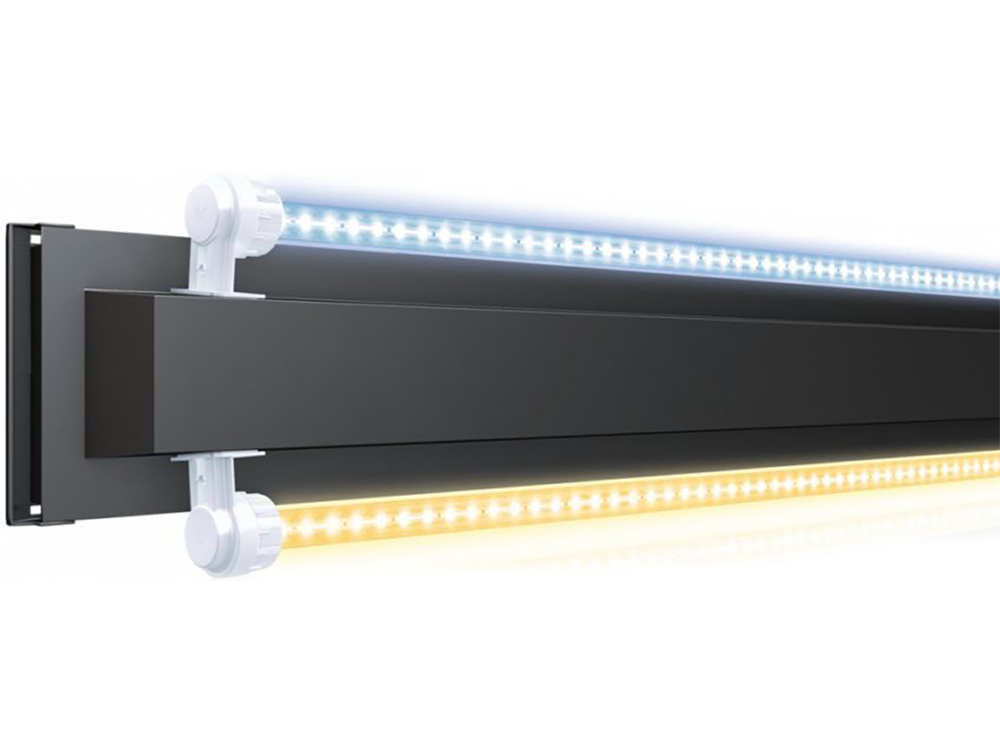How to change from fluorescent to LED aquarium lighting
For decades, the most popular form of lighting available to aquarists were fluorescent tubes. In sizes such as T12 (1 ½” diameter) T8 (1” diameter,) and T5 (⅝” diameter) fluorescent tubes were highly effective at lighting fish, enhancing colours, and for growing plants or corals.
But there is another way. LED.
The good news is that fluorescent light tubes haven’t disappeared altogether. If you are shopping for a replacement T8 or T5 light tube, you can still purchase one. Just check the length in mm is the same, check its T8 or T5, and the wattage, and it will fit and run no problem.
But as time goes on, fluorescent light tubes are lacking some eco credentials, and governments may look to phase them out entirely in the coming years. In the home, in industry, and in aquariums.
LED lights don’t contain mercury, so are easier to recycle than fluorescents. They are also capable of producing more light per watt of energy used, than fluorescents, meaning an energy saving and lower running costs. And on top of all that, some are controllable, meaning that they can be dimmed, programmed, or even change colour.
Swapping to LED
So there are several benefits to swapping from fluorescent lights to LED. But how do you do it? And what happens if your old T8 or T5 fluorescent lamps are built into the hood of your aquarium? Don’t fear, as there are many solutions…
If you want to keep your old hood, lamp holders and light fittings, you need to consider retrofit LED lamps. The most straight forward retrofits are those provided by Arcadia and Aquarium Systems.
They are the same length, same diameter, have the same pins on the end, and can even be powered by the same ballast as your old T8 or T5 lamp. Just make sure you choose the right model to replace T8, or T5.
But if your old light ballast has failed, you have lots of options there too. AquaEl and TMC produce retrofit LED lights to replace T8 and T5 fluorescents, but this time they come with their own dedicated power supply.
This enables them to use the old lamp holders and physically replace the old fluorescent, by way of special lamp holder adaptors. But the lights themselves have a separate power supply. All of the above LEDs are slimline and will fit inside closed hoods, cover glasses, and integral light units. Make sure you get the right length if replacing Juwel fluorescent lamps.
Removing the hood
An old, defunct hood can be removed entirely, freeing you up to choose many different tank mounting lights from Arcadia, Aquarium Systems, AquaEl, Fluval and TMC. Designed to be length adjustable, these units can mount directly onto the tank rim, making them easy to fit and remove, or to slide back, out of the way for maintenance.
And with the whole top of the tank open, you can fit as many light units on as you would like.
High spec LED lighting
If you want to upgrade your existing aquarium to one which will grow demanding corals, you may want to consider high-powered LED lighting.
Fan cooled, models from Kessil and Aqua Illuminations can be mounted to open-topped tanks and are controllable, enabling spectral control and advanced programming features like automated dimming and timed lighting cycles. Even Wi-Fi control, by way of an app.
And if you don’t like any fan noise, models from Fluval and TMC Aquaray offer a nice halfway house.
FAQs
Can I reuse the reflectors from my fluorescent lamp?
You don’t need reflectors with retrofit LEDs as all the light is directed down into the aquarium
How long do LEDs last?
LED lamps can last up to 50,000 hours, depending on the make and model, which equates to over five years of continuous use, but check what the manufacturer states before you purchase, and keep proof of purchase.
Another big advantage with LED is that brightness tends not to drop off so much with age, like with fluorescent or LED. Light output can be measured with a Seneye Reef aquarium monitor.
Are all LED lamps controllable?
No, so check before purchase. All could be turned on and off by way of a simple plug-in light timer (not supplied,) but not all can be dimmed, have a controller, or an app, so check.
As a very general rule, most low priced LED lamps have the least light output and least controllability, with highly-priced units tending to be the brightest, and the most feature-rich. Lamp controllers also tend to be non-transferable from manufacturer to manufacturer, and will only control one make of light.
Which colour LED should I choose?
LED lamps are provided just like fluorescents, being suitable either for freshwater or marine, and enhancing either colours, plants, or coral growth.
If limited to just one LED lamp, you’ll need an all-rounder, for freshwater, or marine. Or if budget allows, high-spec LEDs like those from Aqua Illuminations can produce all the colours of the rainbow.









